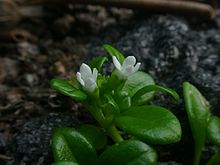- Hedyotis
-
Hedyotis 
Hedyotis biflora Scientific classification Kingdom: Plantae (unranked): Angiosperms (unranked): Eudicots (unranked): Asterids Order: Gentianales Family: Rubiaceae Subfamily: Rubioideae Tribe: Spermacoceae Genus: Hedyotis
L.Type species Hedyotis fruticosa
L.Species ~ 115 species, see text
Hedyotis is a genus of flowering plants in the family Rubiaceae. Many species of this genus such as Hedyotis biflora, H. corymbosa and H. diffusa are well known medicinal plants. The hedyotis is native to tropical and subtropical Asia and to islands of the northwest Pacific. [1] It comprises about 115 species. [2] The type species for the genus is Hedyotis fruticosa. [3]
Hedyotis was named by Linnaeus in 1753 in Species Plantarum. [4] This generic name is derived from two Greek words, hedys, "sweet", and otos, "ear", in reference to the sweet-scented, ear-shaped leaves of some species. [5]
Hedyotis was formerly defined very broadly by some authors, and included species now placed in Oldenlandia, Oldenlandiopsis, Houstonia, Kadua, and other genera. It is now circumscribed more narrowly, as a monophyletic group that is closely related to Agathisanthemum. [6]
Species include:
- Hedyotis acuminata
- Hedyotis cookiana
- Hedyotis coriacea
- Hedyotis degeneri
- Hedyotis diffusa
- Hedyotis flynnii
- Hedyotis littoralis
- Hedyotis mannii
- Hedyotis parvula
- Hedyotis purpurea
- Hedyotis schlechtendahliana
- Hedyotis st.-johnii
- Hedyotis terminalis
- Hedyotis vegrandis
Research
In the traditional medicine, over 20 Hedyotis species have been used for treatment of diseases and in healing practices. The most popular among these are Hedyotis diffusa and Hedyotis corymbosa which are active principles in several Chinese remedies such as bai hua she she cao, peh hue juwa chi cao and feibao syrup. They are taken for treatment of cancers, infections and other diseases. Phytochemical investigation of Hedyotis species was first published in 1933 upon examining the active components of the medicinal plant H. auricularia [7]. Since then, over 50 novel compounds have been isolated from various member of the Hedyotis genus. These compounds have highly divergent structures including alkaloids, anthraquinones, flavonoids, iridoids, triterpenoids, sterols, lignans and a number of other compounds [8].
Recently, two novel biological active peptides, hedyotide B1 and B2 (hedyotide = hedyotis + peptide), have been isolated from the ariel parts of the medicinal plant Hedyotis biflora [9]. H. biflora is a small annual herb traditionally used to treat body pain in fever and malaria. Both hedyotide B1 and B2 belong to the cyclotide superfamily which was known to be an important part of plant innate defense. Hedyotide B1 has a cyclic-cystine-knot motif and displayed potent broad-spectrum activites against many bacteria including E. coli, S. salivarius, S. aureus, P. aeruginosa, B. cereus and B. megaterium [10]. Hedyotide B1 and cyclotides are likely to exerted their antimicrobial actions by disrupting the bacteria membranes which eventually leads to cell death. As they target directly bacterial membranes. it is unlikely for bacteria to develop resistance. Therefore, hedyotide B1 with a novel mode of action has potential as a novel antimicrobial agent against drug-resistance bacteria.
References
- ^ David J. Mabberley. 2008. Mabberley's Plant-Book third edition (2008). Cambridge University Press: UK. ISBN 978-0-521-82071-4
- ^ Inge Groeninckx, Steven Dessein, Helga Ochoterena, Claes Persson, Timothy J. Motley, Jesper Kårehed, Birgitta Bremer, Suzy Huysmans, and Erik Smets. 2009. "Phylogeny of the herbaceous tribe Spermacoceae (Rubiaceae) based on plastid DNA data". Annals of the Missouri Botanical Garden 96(1):109-132.
- ^ Hedyotis In: Index Nominum Genericorum. In: Regnum Vegetabile (see External links below).
- ^ Carolus Linnaeus. 1753. Species Plantarum 1:101. Laurentii Salvii. (see External Links below).
- ^ Umberto Quattrocchi. 2000. CRC World Dictionary of Plant Names volume II. CRC Press: Boca Raton; New York; Washington,DC;, USA. London, UK. ISBN 978-0-8493-2676-9.
- ^ Jesper Kårehed, Inge Groeninckx, Steven Dessein, Timothy J. Motley, and Birgitta Bremer. 2008. "The phylogenetic utility of chloroplast and nuclear DNA markers and the phylogeny of the Rubiaceae tribe Spermacoceae". Molecular Phylogenetics and Evolution 49(3):843-866. doi:10.1016/j.ympev.2008.09.025
- ^ Ahmad NHLaR: Phytochemical studies and pharmacological activities of plants in genus Hedyotis/Oldenlandia Studies in Natural Products Chemistry 2006, 33(13):1057-1090.
- ^ Ahmad NHLaR: Phytochemical studies and pharmacological activities of plants in genus Hedyotis/Oldenlandia Studies in Natural Products Chemistry 2006, 33(13):1057-1090.
- ^ Nguyen GK, Zhang S, Wang W, Wong CT, Nguyen NT, Tam JP: Discovery of a linear cyclotide from the bracelet subfamily and its disulfide mapping by top-down mass spectrometry. J Biol Chem. http://www.jbc.org/content/early/2011/10/06/jbc.M111.290296.abstract
- ^ Wong CTT, Taichi M, Nishio H, Nishiuchi Y, Tam JP: Optimal Oxidative Folding of the Novel Antimicrobial Cyclotide from Hedyotis biflora Requires High Alcohol Concentrations. Biochemistry (Mosc) 2011, 50(33):7275-7283.
External links
- Hedyotis At: Search Page At: World Checklist of Rubiaceae At: Index by Team At: Projects At: Science Directory At: Scientific Research and Data At: Kew Gardens
- Hedyotis At:Index Nominum Genericorum At: References At: NMNH Department of Botany
- Hedyotis In: volume I Of: Species Plantarum At: Titles At: Biodiversity Heritage Library
Categories:
Wikimedia Foundation. 2010.
